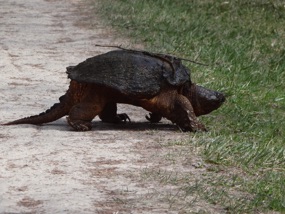Turtle on the Towpath
Along the greenway of the D&R Canal,
midway from Trenton to Manville,
jogging north from Griggstown,
I take it one step
at a time, out
and back
the towpath beside the quiet water.
Down the bank on the other side
the Millstone River's flood plain
leans with me, combed and torn
by run-off from heavy rain.
Begin again
each step, trying to forget the clock,
though I know each interval
from cobbled spillway to lock
to leaning mile-
stone. Then
comes turtle up the steep bank
gripping with huge rootfin
the towpath here and here.
Neither of us
breaks stride.
Stump, stone, night, through scattered light
and green, through song of thrush
and warbler, and rush of air
off westward highlands,
I run wondering how
the turtle knew
the canal
was there. A trail it left behind?
Fragrance of mallow and pond
lily pouring down the bank?
Or the pull of water
and earth suspended:
"this way"
turtle
running now
in a different map
of the greenway, farther
from Griggstown than intended.
I was jogging one day on the tow path of the D & R Canal when I encountered a snapping turtle crossing the tow path, heading toward the canal. I had been reading a Paris Review interview with Gary Snyder about his method of composition: "The first step is the rhythmic measure, the second step is a set of preverbal visual images which move to the rhythmic measure, and the third step is embodying it in words--and I have learned as a discipline over the years to avoid writing until I have to." So I began composing this poem during that run, trying to find a rhythm and form that mirrored somehow the cadence of motion and breath as I ran.

And as for the snapping turtle, well, Gary Snyder has something to say about that as well. In an essay entitled "The Practice of the Wild," Snyder draws a distintion between wilderness places (dwindling, especially here on the eastern edge of Turtle Island) and wildness as a quality of life that can occur anywhere: "Exquisite complex beings in their energy webs inhabiting the fertile corners of the urban world in accord with the rules of wild systems, the visible hardy stalks and stems of vacant lots and railroads, the persistent raccoon squads, bacteria in the loam and in our yogurt.... Civilization is permeable.... Wilderness may temporarily dwindle, but wildness won't go away." At least, that's what the turtle on the tow path told me.